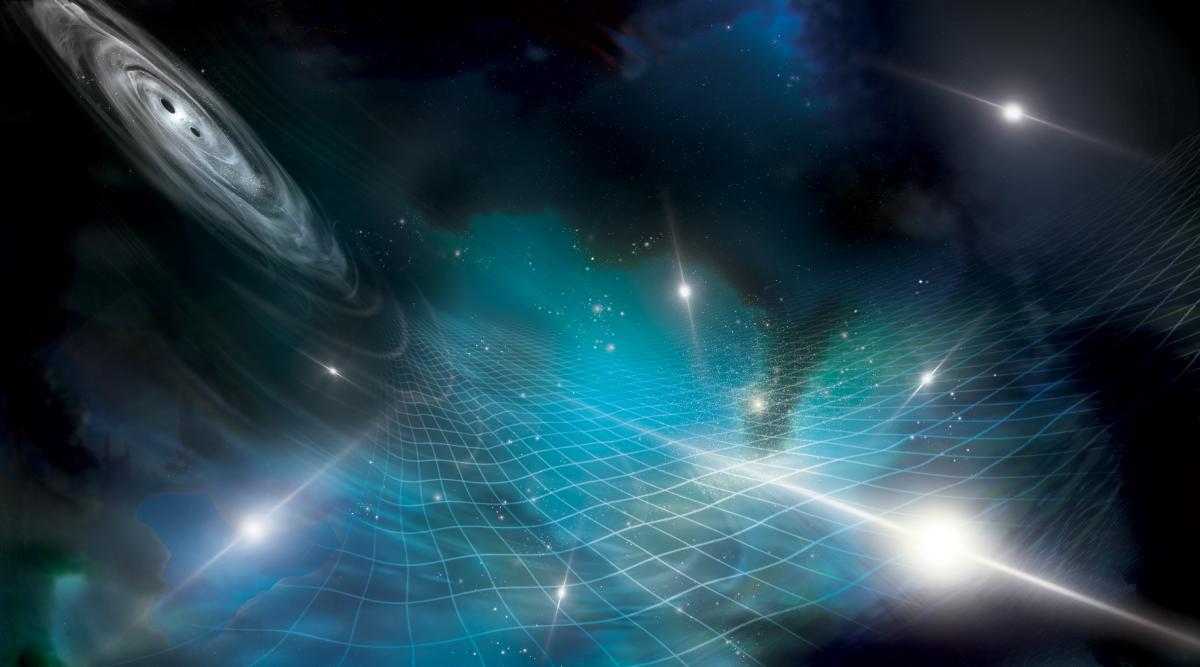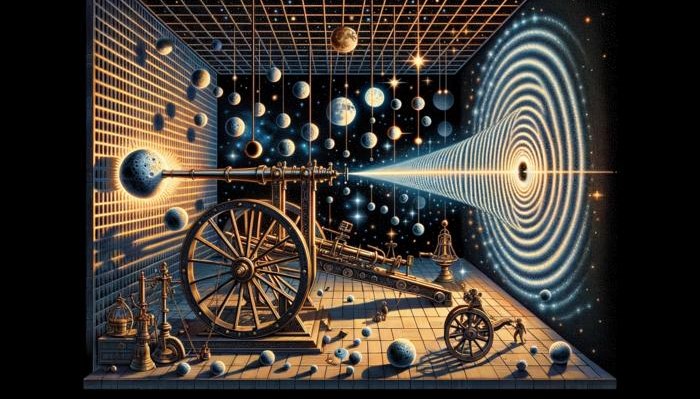
A new theory suggests that the unification between quantum physics and general relativity has eluded scientists for 100 years because huge "fluctuations" in space and time mean that gravity won't play by quantum rules.
Since the early 20th century, two revolutionary theories have defined our fundamental understanding of the physics that governs the universe. Quantum physics describes the physics of the small, at scales tinier than the atom, telling us how fundamental particles like electrons and photons interact and are governed. General relativity, on the other hand, describes the universe at tremendous scales, telling us how planets move around stars, how stars can die and collapse to birth black holes, and how galaxies cluster together to build the largest structures in the cosmos.
Since their development, these two theories have grown more robust and have bolstered science with their tremendous success. Quantum mechanics has shown that the quantum world is replete with counterintuitive aspects, like the existence of systems simultaneously in contradictory states or particles instantly influencing each other, even at opposite ends of the universe. General relativity, meanwhile, has revealed that the very fabric of space-time is shaped by the matter sitting upon it, and that violent interactions between bodies of great mass can create ripples in space-time known as gravitational waves that can travel for billions of light-years to wash over Earth.
Yet, there is a problem, a dark cloud that hangs over these disciplines: As these two pillars of physics are perfected, scientists are still unable to bridge the gulf between them.
Related: How dancing black holes get close enough to merge
"The two pillars of modern physics are inconsistent with each other, which means that there is a fundamental contradiction which lies in the very foundation of our laws of nature," University College London (UCL) Professor Jonathan Oppenheim told Space.com via email.
Oppenheim is the pioneer of a new and radical theory that could finally bring together these two concepts, a reconciliation that has defied the greatest scientific minds for over 100 years.
Why should gravity be 'quantum' at all?
Previously, uniting general relativity with quantum physics has meant taking space-time — the three dimensions of space and the one dimension of time, unified as a single 4D entity that is at the foundation of general relativity — and breaking it down into discrete units, or "quanta."
This requires space-time to be a passive stage on which the "action" of the universe plays out. However, general relativity hinges on space-time not being a static stage but rather a dynamic player in the universe's cosmic ballet, shaped by the presence of matter and energy and subsequently telling matter and energy how to move via the curvature and gravity that arises from it.
Oppenheim's idea of "waving space-time" is based upon asking why gravity should have a quantum nature like that which has been discovered for the universe's other fundamental forces — electromagnetism, and the strong and weak nuclear forces. Gravity, he argues, isn't like these other forces. After all, it is the only one of the four that can define the very geometry of space-time, and the fields of quantum physics evolve upon this geometry.
"We feel gravity because matter causes space-time to bend. Time flows at unequal rates at different locations," Oppenheim writes in a paper discussing his theory published in the journal Physical Review X. "The rate at which time flows and the causal structure [the fact that cause always precedes effect] it provides may be required to have a classical description in order for quantum theory to be well-formulated."
That means, according to his theory, termed a "postquantum theory of classical gravity," that space-time, and thus gravity, don't have quantum description. That's thanks to random fluctuations in space-time, which cause changes in the flow of time, thus breaking the concept of predictability.
"In both quantum gravity and classical gravity, space-time must be undergoing violent and random fluctuations all around us, but on a scale which we haven't yet been able to detect," Zach Weller-Davies, a researcher at the Perimeter Institute of Theoretical Physics in Canada and a former Ph.D. student of Oppenheim's, said in a statement.
Related: What is the theory of general relativity?

Betting on 'wavy space-time' vs. string theory and quantum loop gravity
Of course, Oppenheim's idea is far from the first theory that has been proposed to heal the division between quantum physics and general relativity.
String theory is one of the most well-known concepts suggested to unite these two pillars of physics. In short, it views the particles that fill the universe as manifestations of one-dimensional vibrating objects called strings. String theory describes how these strings propagate through space and interact with each other, giving rise to a particle called a graviton that carries gravitational force and thus provides a quantum account of this fundamental force.
A popular alternative unification theory to string theory is quantum loop gravity, which changes the formulation of general relativity to quantize space-time into chunks.
Quantum loop gravity supporter Carlo Rovelli and string theory proponent Geoff Penington doubt Oppenheim's postquantum theory of classical gravity. Their skepticism is the basis of a 5,000-to-1 odds bet with Oppenheim, which would be paid out upon the failure of an experiment devised by Weller-Davies and other former Ph.D. students of the UCL scientist to measure a mass very precisely to see if it appears to fluctuate over time — thus confirming the postquantum theory of classical gravity.
This skepticism is a two-way street for Oppenheim, as he doubts the validity of string theory and quantum loop gravity as accurate remedies to the quantum physics-general relativity problem. This is because these other ideas require extra ingredients to be added to the universe, including additional dimensions, that the postquantum theory of classical gravity doesn't need.
"It's unclear to me whether any of the current approaches consistently reconcile quantum theory and general relativity," Oppenheim said. "If string theory does manage to do so, it would require extra dimensions and supersymmetry, neither of which we have observed in nature, although it's still possible they are there."
He added that unitary theories, such as string theory and loop quantum gravity, also appear to require the breaking of Einstein's famous equivalence principle . This refers to the equity between two forms of mass — gravitational mass, experienced when standing on a body like Earth, and inertial mass, experienced in an accelerating frame of reference. Oppenheim explained that this equivalence breaking is needed to reconcile these theories with the "black hole information paradox," which asks where the information carried by matter swallowed by black holes goes.
In addition to testing the fluctuation of a set mass due to the postquantum theory of classical gravity, Oppenheim and his former students are on the lookout for aspects of nature that may emerge and further support this novel theory.
"We have shown that if space-time doesn't have a quantum nature, then there must be random fluctuations in the curvature of space-time which have a particular signature that can be verified experimentally," Zach Weller-Davies said. "If space-time is classical, the fluctuations have to be larger than a certain scale, and this scale can be determined by another experiment where we test how long we can put a heavy atom in superposition of being in two different locations."







